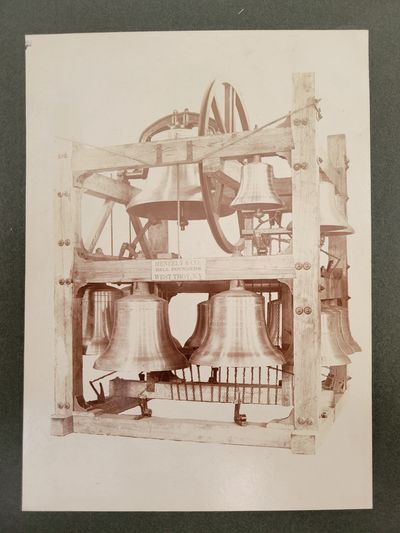Chime stand restoration
Unlike carillons, the American bell founders built most of the chimes in the North America. A chime consists of 8 to 22 bells that are designed to play melodies. There is an argument that can be made as to when and who create the first chime in North America, but what can’t be argued is the first well documented chime was cast in North America in 1848 in Boston. The chime was played using an automated wheel that was run from the tower clock. It wasn’t long after this that other American bell founders figured out how to cast bells that rang different notes and hooked them up to a playing stand where a musician could play simple, single note melodies.
Most of the chime stands created by the bell founders basically resemble one another, with nice, furniture-grade wood making up the end posts and horizontal spreaders. The handles to play the bells resembled farming plow handles. Although they resembled each other in basic design, each founder would try to outdo their competitors by creating functional furniture, sometimes even using brass or bronze to dress the playing stands up.
Beginning in 1848, through 1900, there were 183 chimes cast by 9 different American bell founders and an additional 8 chimes cast by European bell founders in North America. Every one of these chimes were played either using a traditional wooden chime stand or a tight rope system known as an Ellacombe Stand. This way of playing the bell uses ropes, one side tied to the clapper inside the bell and the other side tied to the floor, below the bells in the playing room. The player would simply pull on the rope to play the desired bell.
Traditionally, chime stands were built without pedals but as the chimes began to grow to over 10 bells, they slowly began to incorporate pedals to make it a little easier for the player to be able to use all of the bells.
Today, there are over 600 chimes that exist in North America. Many of the instruments still use the original chime stands to play the bells. As we have traveled around North America working on these historical instruments, we often find these amazing pieces abandoned in the bell towers, forgotten and left to rot away. Even though these stands are old and worn, they can be restored back to the beautiful pieces that they once were. T. Verdin Legacy Bellworks can restore them back to the original playing condition by reworking the stands or even by building replica chime stands that look and function exactly like the original ones.

Chime Stands

Traditional American Chime Stand (without pedals) built by the McShane Bell Foundry in the early 1920's.

Traditional American Chime Stand (with pedals) built by Meneely & Company Bell Foundry of Trot, NY in the mid 1920's

Example of an early Ellacombe Ringing Stand. This one is at St. Peter's Episcopal Church in Philidelphia.
ceCopyright © 2025 T Verdin Legacy Bellworks - All Rights Reserved.
This website uses cookies.
We use cookies to analyze website traffic and optimize your website experience. By accepting our use of cookies, your data will be aggregated with all other user data.